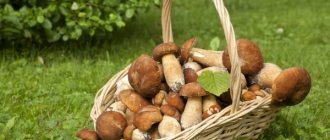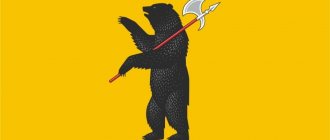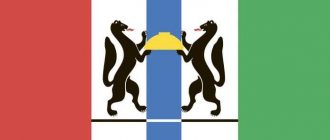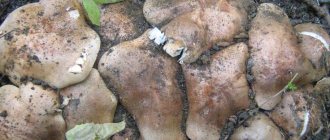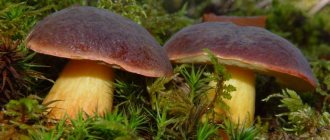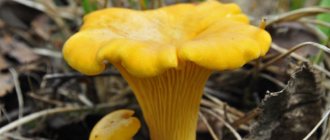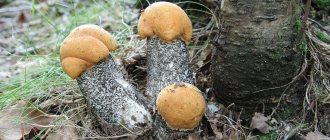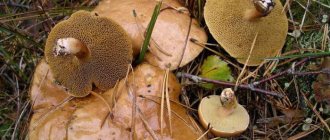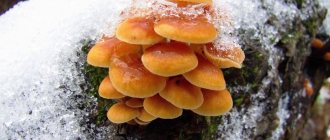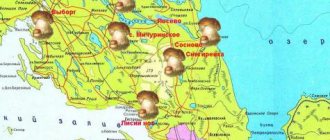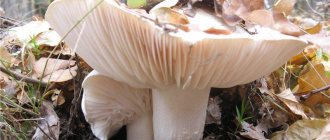Anyone who has not been to the Sverdlovsk region will not understand the beauty of this region! Rich mountain ranges, the charm of nature, manifested in the fragrance of flowers and forest landscapes. A paradise for outdoor enthusiasts and residents of this beautiful region. But these are not all the advantages that you can see when you arrive in the forest. In spring, summer and autumn, the forest line gives its guests its fruits. Berries, fruits, tasty and aromatic mushrooms of the Sverdlovsk region 2022 - a treasure for lovers of natural products. But if you can deal with berry and fruit crops on your own, quiet hunting requires more careful attention: studying the mushroom map and the places where mushrooms grow, the ability to distinguish edible crops from conditionally edible, inedible and poisonous ones, as well as knowledge of usefulness and harm from the use of each type.
Lake Tavatuy
The fourth point in the rating is for those who prefer to walk less and collect by the handful. We will talk about honey mushrooms. They love swamps, dampness and stumps. Such places in the Sverdlovsk region can be found in the area of Lake Tavatuy. I recommend taking any bus towards Nevyansk. Next, after passing the “Tavatui” sign, you should get out and go to the side of the lake. For this route, be sure to wear waterproof shoes!
Edible species
Mushrooms collected in the Middle Urals are divided into three categories: with strong, medium and weak aroma. The first group includes: white boletus, boletus and boletus. The taste and aroma of saffron milk caps, russula and honey mushrooms are average. The main trophy of a quiet hunt is the porcini mushroom. The favorite place for this species to grow is mixed forests. They prefer dry soils.
The white one exudes a pleasant aroma and has fleshy flesh. A round cap is planted on a thick stem, the color of which can be from light beige to brown. It depends on the place where the porcini mushroom grows. In coniferous forests, the cap may have a reddish tint.
Other widely collected edible mushrooms in the region:
- Chanterelles . It grows most in mixed forests. Their yellow-orange body is easy to spot among grass and foliage. This is a densely growing mushroom that is never affected by worms. In the region, the mass maturation of chanterelles occurs in two waves.
- Milk mushrooms . Mostly white species with a slightly concave cap grow in the region. At the break site they always secrete juice. Because of their excellent pickling characteristics, milk mushrooms are often called royal mushrooms. They belong to the genus Milky. This group includes saffron milk caps and russula.
- Boletuses or redheads. People often call them also: aspen trees, kvasyuki, geese. They have a stable leg. The cut quickly turns blue. The color of the cap ranges from white to orange. They mainly grow in deciduous and mixed forests.
- Boletus mushrooms . Mushrooms with a dense, wide cap of dark brown color and a slender grayish or beige stem. Unlike boletuses, the cut of boletus does not darken. Grows mainly in mixed forests.
- Butter . Mushrooms with a brown cap that is slippery to the touch. have a laxative effect. They grow mainly in young spruce forests.
- Kozlyak. It has a slightly swollen cap, brown or red in color. As it grows, it straightens out. Requires mandatory long-term heat treatment.
- Saffron milk caps. They have a funnel-shaped cap covered with orange skin. The cylindrical leg is the same color.
- Moss flyers. They are similar in appearance to boletus mushrooms, but have a thinner stem. The inside of the cap resembles a sponge. A blue color immediately appears on the cut of moss mushrooms.
Photo gallery
gubanovaolga18
natalya_chukavova
setasetatop
Rocks of Peter Gronsky
The sixth point will be useful for those who like to combine searching for mushrooms with a walk. If it is important for you to admire the Ural landscapes and would like to bring a basket of mushrooms for dinner, then the most suitable direction is the Peter Gronsky rocks. You can get there by train towards N. Tagil. Get off at station 479 km. How to combine two goals? You can walk to the rocks, climb there, and take beautiful photos. Organize a picnic at the top. On the way back, going down to the station, pick mushrooms a little further than the tourist trails. Here your catch can be varied. There will be boletus and saffron milk caps, porcini mushrooms and boletus mushrooms. And... lots of blueberries!
Mushrooms of the Sverdlovsk region
The nature of the region and its climate are ideal for their growth. The region is conventionally divided into three zones: wet forests, forest-steppes and dry coppices. Each zone has its own set of mushroom species. In the east of the region there are fields and steppes, separated by small copses. During the rainy season, mushroom pickers here collect several baskets of butter mushrooms and milk mushrooms in one trip.
Coat of arms and flag of the Sverdlovsk region
The southern part of the region is covered with dry forests rich in mushrooms for pickling: trumpets and milk mushrooms. Saffron milk caps, russula and boletus also grow in them. Swampy forests cover a significant part of the West Siberian Lowland. It is dangerous for people who do not know the area to collect here without them. There are many swamps here, where it is easy to get lost.
Expert opinion
Gennady Sergeevich Rylov
A great expert in mycology and an avid mushroom picker. Knows everything about mushrooms, their types and places of growth
Despite this, avid mushroom pickers love to go to these places for “quiet hunting”, as to the most ecologically clean zone of the region. Connoisseurs of the local forests and swamps are never left without a harvest, even in the driest year.
Growth of honey mushrooms
Like any other mushrooms, honey mushrooms grow quickly. Just a few days after good rain and warm weather, small mushrooms can be detected. However, if the mushroom picker decides to cut only mature fruits, it is better to count 6-7 days from the last rain. During this period, the mushrooms will grow and become easy prey.
You should not go to the forest on weekends and Mondays. If possible, reschedule the outing to any of the four free days: Tuesday, Wednesday, Thursday or Friday. This will reduce competition by up to 80%.
Honey mushrooms in the Urals 2022, as in previous years, were a success! Mushroom pickers collect mushrooms not only in the forest, but also in the meadows. A rich harvest allows you to divide the fruits not only for pickling and freezing, but also for preparing first and second courses.
What to take to the forest?
Don’t forget that you should definitely take mosquito and tick repellent when going to the forest.
Provide comfortable shoes and clothing. Don’t forget to throw a raincoat in your bag, it will come in handy in the Urals! To collect the forest “harvest” we take baskets, buckets or bags. It is better to have a folding knife for cutting mushrooms - it is convenient and safe. For berry lovers, you need to provide plastic (light) containers. Be sure to bring matches, a light first aid kit (plaster, brilliant green pencil) and a snack. It is known that in our area nature is represented mainly by mountain taiga forests, which are a very favorable habitat for mushrooms. That is why our region has been famous for centuries not only for its gemstones, fish and game, but also for its mushroom places. Moreover, we have no, no, and there are hard-to-reach, untrodden forest areas where a mushroom picker’s sharpened knife has never sparkled, and where mushrooms grow so densely that from one square meter you can pick two buckets of them, if not more. Such places are kept secret and not disclosed even under torture with vodka.
But, I digress. In this article, I intend to talk in detail about where in our region the most mushrooms grow, and also about where, due to the presence of large industrial pollutants, it is better not to collect them.
Mushroom places
The Sverdlovsk region is an industrially developed region. This affects its ecology. It is strictly not recommended to collect mushrooms within a radius of 50 km from Yekaterinburg, in most of the Revdinsky and Pervouralsky districts. A sign of a clean area can be an abundance of fly agarics, and contamination by a large number of russula.
Unfavorable places for collecting mushrooms are the suburbs of the cities of Rezh, Artyomovsk, Asbest, Sukhoi Log, Nevyansk, Nizhny Tagil, Krasnouralsk, Nizhnyaya Tura, Karpinsk and Krasnoturinsk. Collecting places here must be done with caution.
Those who like to pick mushrooms by the handful, rather than look for them growing one by one, prefer the vicinity of Lake Tavatui. This place is rich in honey mushrooms. A bus runs here from Yekaterinburg. When going to the lake for a “quiet hunt”, you need to wear waterproof shoes. The soil in its vicinity is quite moist.
The leader of mushroom places is the village of Kashino. In a guide to the Sverdlovsk region, published in 1960, it is labeled as “a paradise for mushroom pickers.” A bus from Yekaterinburg runs to Kashino from the Southern Bus Station. There is especially a lot of oil here.
Corned beef is best collected on Mount Volchikha. Here you can also pick up several baskets of mushrooms for pickling. Volnushki and saffron milk caps often grow next to each other in the same clearing. From Yekaterinburg people travel here by train, heading towards Revda.
Properties
Mushrooms can replace meat
Mushrooms are unique forest organisms that have a lot of beneficial properties. They are determined by their chemical composition.
Benefit
Due to the large amount of proteins, mushrooms can replace animal meat. It is especially valuable for vegetarians who do not receive enough animal proteins necessary for the normal functioning of the body.
A huge amount of vitamins, microelements and amino acids helps in the manufacture of medicines.
Regular consumption of them is a necessity for diabetics, because... mushrooms lower blood sugar levels.
For older people, they help stimulate brain function.
Harm
Dishes with the addition of mushrooms are considered difficult for the stomach, because chitin, which is part of the cell walls of mushrooms, inhibits the functioning of the gastrointestinal tract, and problems may arise associated with the development of food rotting processes in the gastrointestinal tract. This product is also considered allergenic.
Mushrooms absorb all toxins from the environment, so it is important to choose the right environmentally friendly area for collection
Autotramp
We choose where to go on winter weekends on our own, depending on the region and type of route.
Routes suitable for the winter season.
Our website will help you choose the most interesting route within 200 kilometers from the city of Yekaterinburg.
conclusions
As a result, we are left with a not so small part of our region to collect mushrooms. This is the Ivdelsky district and the neighboring Severouralsky and Garinsky districts. Most of the Karpinsky district - except for the eastern outskirts, the Novolyalinsky district, the south of the Serovsky district. Verkhoturye and Alapaevsky districts (except for a small corner south of the regional center), Turinsky , Taborinsky , Tavdinsky and Irbitsky are also seemingly environmentally friendly. Then comes the western part the Shalinsky district, together with its middle, and the lower-lying Achitsky , Krasnoufimsky (but away from the city and Zyurzi [1] It is in this village that there is a warehouse for radioactive materials.), Artinsky and Nizhneserginsky .
Here they are - the most environmentally friendly (including mushroom) places in our region. That's where we'll sharpen our skis. Hang in there, mushrooms!
Notes[]
Notes
| ↑1 | It is in this village that there is a warehouse for radioactive materials. |
Mushroom picker calendar of the Sverdlovsk region
The mushroom season in the region begins in June and ends in September.
Table
| Name. | June. | July. | August. | September. |
| White mushrooms. | V | V | V | V |
| Milk mushrooms. | V | V | V | |
| Chanterelles. | V | V | V | V |
| Honey mushrooms. | V | V | V | |
| Butter. | V | V | V | V |
| Saffron milk caps. | V | V | ||
| Boletus mushrooms. | V | V | V | V |
| Flywheels | V | V |
Poisonous
The most common in the Sverdlovsk region are 7 types of poisonous mushrooms:
- Death cap . More often found in coniferous and broad-leaved forests. It has an external resemblance to champignons and russula. Cap color: light green, brown-olive, white.
- Red fly agaric . Grows in all types of forests. Capable of causing strong hallucinations.
- False honey fungus. A double of ordinary honey mushrooms of sulfur-yellow color. Poisonous mushrooms, like edible ones, grow in large groups on stumps. They have an unpleasant odor.
- Satanic mushroom. Most often found in deciduous forests. With yellowish flesh. The round hat can be painted gray, white, or olive.
- Yellow-skinned champignon. The mushroom has a white cap that turns brown when pressed. Towards the center its color changes to brownish. Grows in deciduous and mixed forests.
- Gall mushroom. It has an external resemblance to boletus. The convex cap is colored brownish-red. The pulp is bitter, with a pinkish tint.
- False chanterelles. They grow mainly in coniferous forests. The hat of false chanterelles is funnel-shaped, with rolled edges, and colored orange-red.
mushrooms_inigo
grazyna.de
Inedible mushrooms
Inedible species include species that can be eaten only after special processing. This group includes dung beetles, bitter beetles, and laticifers. There are inedible mushrooms in the region that are listed in the Red Book. They grow mainly in damp forests. Among them:
- psilocybin mushrooms;
- sheep's albatrellus;
- ishnoderma resinous;
- clavaria is pale brown;
- Onnia tomentosa, etc.
